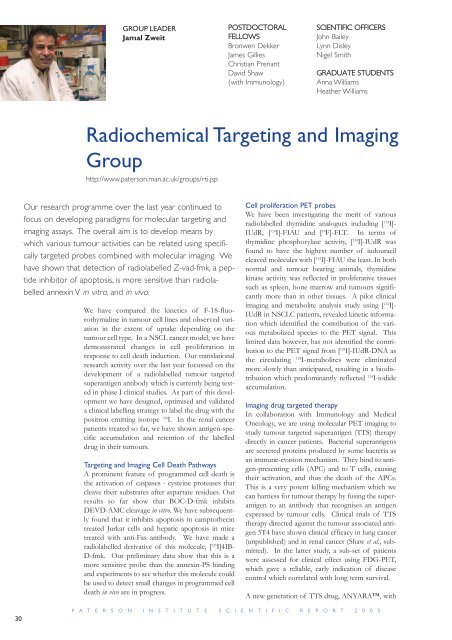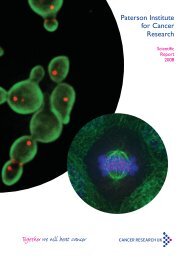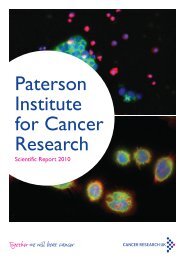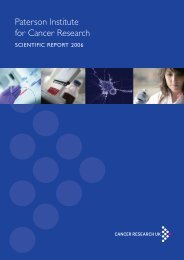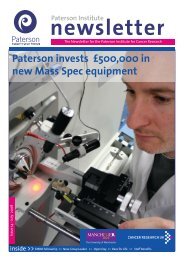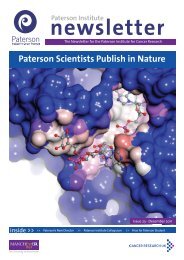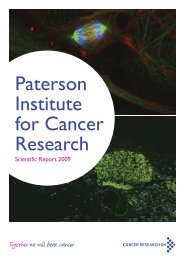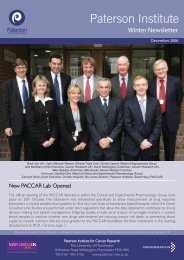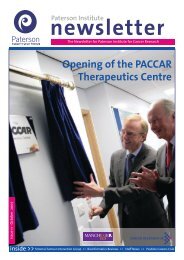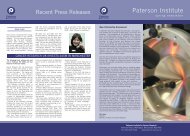Paterson Institute for Cancer Research SCIENTIFIC REPORT 2005
Paterson Institute for Cancer Research SCIENTIFIC REPORT 2005
Paterson Institute for Cancer Research SCIENTIFIC REPORT 2005
Create successful ePaper yourself
Turn your PDF publications into a flip-book with our unique Google optimized e-Paper software.
30<br />
GROUP LEADER<br />
Jamal Zweit<br />
Radiochemical Targeting and Imaging<br />
Group<br />
http://www.paterson.man.ac.uk/groups/rti.jsp<br />
Our research programme over the last year continued to<br />
focus on developing paradigms <strong>for</strong> molecular targeting and<br />
imaging assays. The overall aim is to develop means by<br />
which various tumour activities can be related using specifically<br />
targeted probes combined with molecular imaging. We<br />
have shown that detection of radiolabelled Z-vad-fmk, a peptide<br />
inhibitor of apoptosis, is more sensitive than radiolabelled<br />
annexin V in vitro, and in vivo.<br />
We have compared the kinetics of F-18-fluorothymidine<br />
in tumour cell lines and observed variation<br />
in the extent of uptake depending on the<br />
tumour cell type. In a NSCL cancer model, we have<br />
demonstrated changes in cell proliferation in<br />
response to cell death induction. Our translational<br />
research activity over the last year focussed on the<br />
development of a radiolabelled tumour targeted<br />
superantigen antibody which is currently being tested<br />
in phase I clinical studies. As part of this development<br />
we have designed, optimised and validated<br />
a clinical labelling strategy to label the drug with the<br />
positron emitting isotope 124 I. In the renal cancer<br />
patients treated so far, we have shown antigen-specific<br />
accumulation and retention of the labelled<br />
drug in their tumours.<br />
Targeting and Imaging Cell Death Pathways<br />
A prominent feature of programmed cell death is<br />
the activation of caspases - cysteine proteases that<br />
cleave their substrates after aspartate residues. Our<br />
results so far show that BOC-D-fmk inhibits<br />
DEVD-AMC cleavage in vitro. We have subsequently<br />
found that it inhibits apoptosis in camptothecin<br />
treated Jurkat cells and hepatic apoptosis in mice<br />
treated with anti-Fas antibody. We have made a<br />
radiolabelled derivative of this molecule, [ 125 I]4IB-<br />
D-fmk. Our preliminary data show that this is a<br />
more sensitive probe than the annexin-PS binding<br />
and experiments to see whether this molecule could<br />
be used to detect small changes in programmed cell<br />
death in vivo are in progress.<br />
POSTDOCTORAL<br />
FELLOWS<br />
Bronwen Dekker<br />
James Gillies<br />
Christian Prenant<br />
David Shaw<br />
(with Immunology)<br />
<strong>SCIENTIFIC</strong> OFFICERS<br />
John Bailey<br />
Lynn Disley<br />
Nigel Smith<br />
GRADUATE STUDENTS<br />
Anna Williams<br />
Heather Williams<br />
Cell proliferation PET probes<br />
We have been investigating the merit of various<br />
radiolabelled thymidine analogues including [ 124 I]-<br />
IUdR, [ 124 I]-FIAU and [ 18 F]-FLT. In terms of<br />
thymidine phosphorylase activity, [ 124 I]-IUdR was<br />
found to have the highest number of iudouracil<br />
cleaved molecules with [ 124 I]-FIAU the least. In both<br />
normal and tumour bearing animals, thymidine<br />
kinase activity was reflected in proliferative tissues<br />
such as spleen, bone marrow and tumours significantly<br />
more than in other tissues. A pilot clinical<br />
imaging and metabolite analysis study using [ 124 I]-<br />
IUdR in NSCLC patients, revealed kinetic in<strong>for</strong>mation<br />
which identified the contribution of the various<br />
metabolized species to the PET signal. This<br />
limited data however, has not identified the contribution<br />
to the PET signal from [ 124 I]-IUdR-DNA as<br />
the circulating 124 I-metabolites were eliminated<br />
more slowly than anticipated, resulting in a biodistribution<br />
which predominantly reflected 124 I-iodide<br />
accumulation.<br />
Imaging drug targeted therapy<br />
In collaboration with Immunology and Medical<br />
Oncology, we are using molecular PET imaging to<br />
study tumour targeted superantigen (TTS) therapy<br />
directly in cancer patients. Bacterial superantigens<br />
are secreted proteins produced by some bacteria as<br />
an immune-evasion mechanism. They bind to antigen-presenting<br />
cells (APC) and to T cells, causing<br />
their activation, and thus the death of the APCs.<br />
This is a very potent killing mechanism which we<br />
can harness <strong>for</strong> tumour therapy by fusing the superantigen<br />
to an antibody that recognises an antigen<br />
expressed by tumour cells. Clinical trials of TTS<br />
therapy directed against the tumour associated antigen<br />
5T4 have shown clinical efficacy in lung cancer<br />
(unpublished) and in renal cancer (Shaw et al., submitted).<br />
In the latter study, a sub-set of patients<br />
were assessed <strong>for</strong> clinical effect using FDG-PET,<br />
which gave a reliable, early indication of disease<br />
control which correlated with long term survival.<br />
A new generation of TTS drug, ANYARA, with<br />
P A T E R S O N I N S T I T U T E S C I E N T I F I C R E P O R T 2 0 0 5


